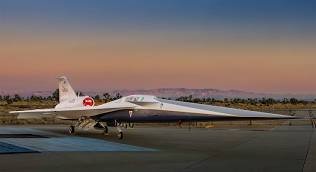NASA’s X-59 QueSST supersonic plane is set to revolutionize air travel with its ability to travel faster than the speed of sound. This groundbreaking aircraft is designed to minimize the sonic boom typically associated with supersonic flight, making it possible for commercial flights to travel at supersonic speeds over land without causing disturbance to those on the ground. The X-59 QueSST, short for Quiet Supersonic Technology, is being developed by NASA in collaboration with Lockheed Martin.
Nasa recently shared the post on the development of the X-59 Supersonic plain on NASAs X.com (formally twitter.com) profile.

The goal of this project is to create a new generation of aircraft that can fly faster than sound without producing the loud and disruptive sonic boom. By reducing the intensity of the sonic boom, the X-59 QueSST aims to make supersonic travel more socially acceptable and environmentally friendly. One of the key features of the X-59 QueSST is its unique shape.
The aircraft has a long, slender design with a sharply pointed nose and a delta wing configuration. This shape helps to control the shockwaves generated by the aircraft as it moves through the air, reducing the sonic boom to a mere thump or a series of soft thuds.
This breakthrough in aerodynamics allows the X-59 QueSST to fly faster than sound without causing the disruptive noise associated with traditional supersonic aircraft. In addition to its innovative design, the X-59 QueSST will also be equipped with advanced avionics and flight control systems to ensure safe and efficient operation.
The aircraft will undergo rigorous testing and evaluation to validate its performance and demonstrate its ability to fly supersonically without disturbing the peace on the ground. While the X-59 QueSST is primarily a research aircraft, its development represents a significant step towards the future of commercial supersonic travel. By addressing the noise concerns associated with supersonic flight, NASA and Lockheed Martin are paving the way for a new era of faster and more efficient air travel.
In conclusion, the X-59 QueSST supersonic plane is an exciting development in aviation technology. With its ability to travel faster than sound while minimizing the sonic boom, this aircraft has the potential to revolutionize the way we travel. As NASA and Lockheed Martin continue to work on this project, we can look forward to a future where supersonic travel is not only faster but also quieter and more sustainable.
if you want to know more about health news then visit GymBag4U – Your Fitness is Our Passion
